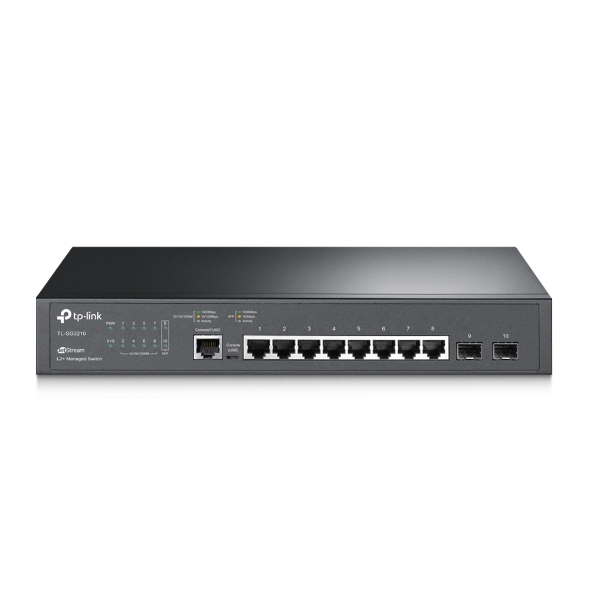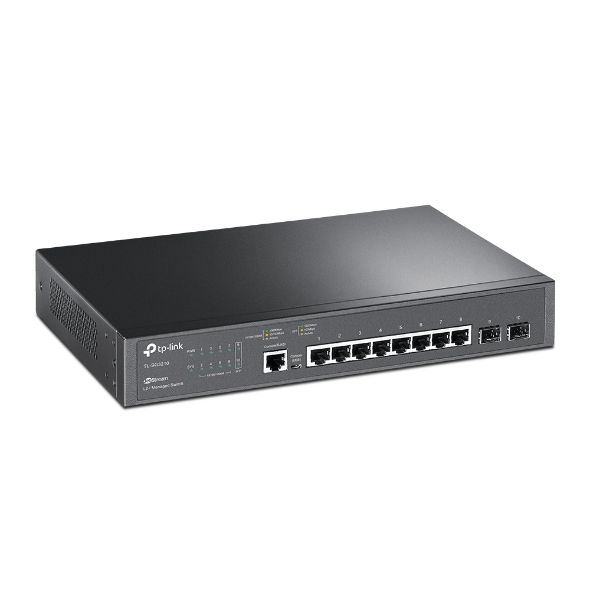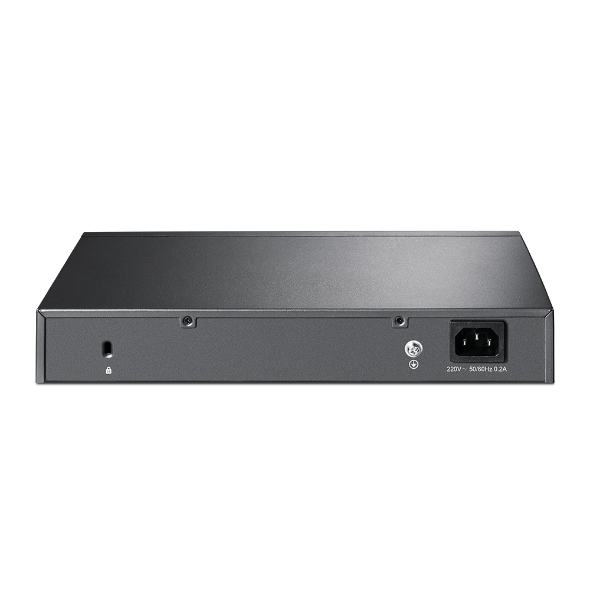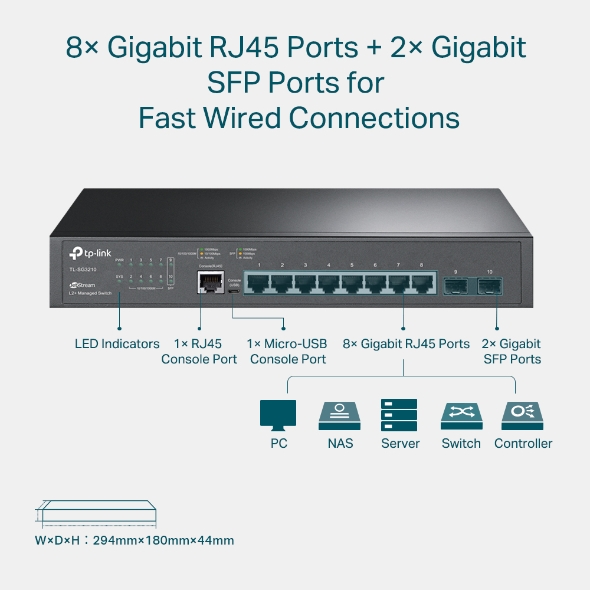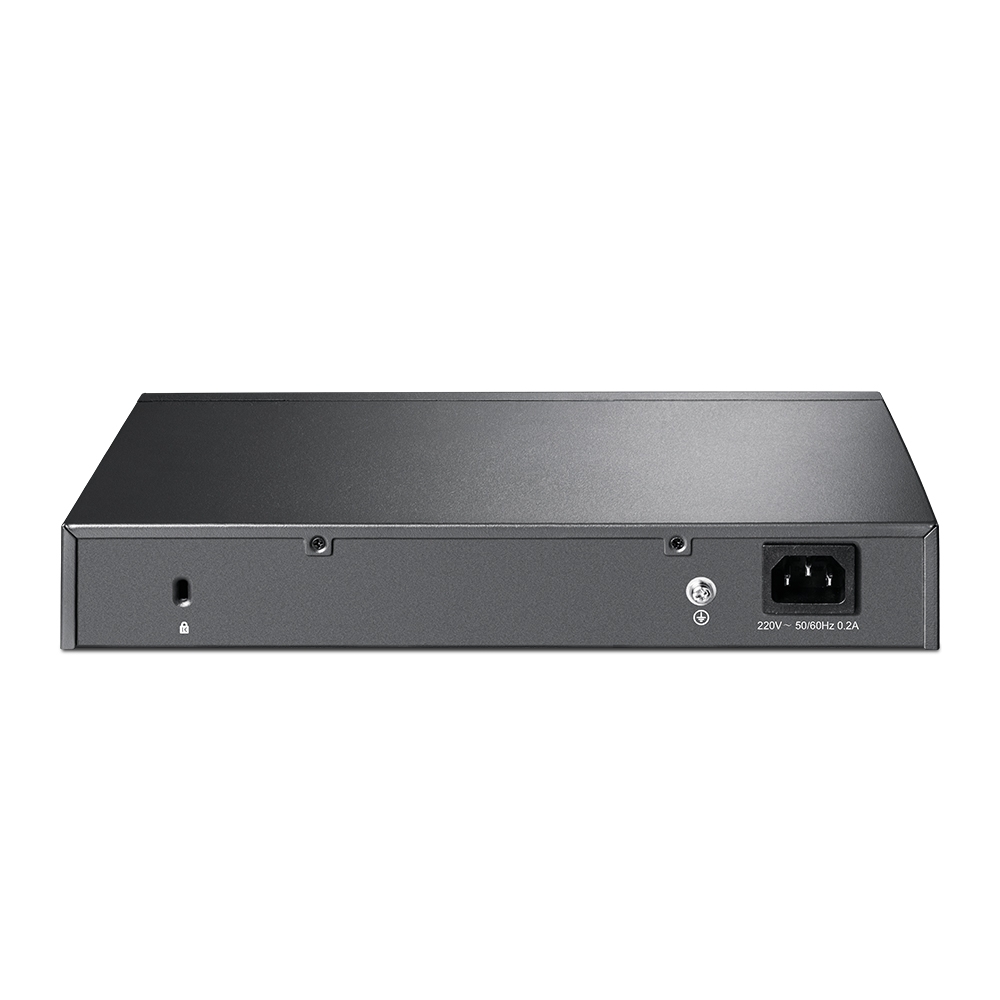Switch JetStream™ administrable niveau 2 avec 8 ports Gigabit avec 2 emplacements SFP
- Le groupage IP-MAC-Port-VID, l’ACL, la sécurité par port, la défense DoS, le Storm control, le snooping DHCP, l’authentification 802.1X et Radius vous offrent des stratégies de sécurité efficaces.
- Les fonctions QoS L2/L3/L4 et snooping IGMP permettent d'optimiser les applications voix et vidéo.
- Les modes d'administration WEB/CLI, SNMP et RMON offrent une multitude de fonctionnalités de gestion.
GARANTIE A VIE
Fonctions
Le switch TP-LINK JetStream™ administrable niveau2 Gigabit TL-SG3210 de TP-LINK fournit 8 ports 10/100/1000 Mbps. Le switch fournit une haute performance, un QoS niveau entreprise, des stratégies de sécurité avancées et des fonctions de gestion avancées Layer 2. De plus, le switch est équipé de 2 emplacements SFP, étendant la flexibilité de votre réseau. Ce switch administrable L2 JetStreamTM Gigabit est rentable pour les petites et moyennes entreprises.
Le TL-SG3210 est pourvu d’une solide sécurité et de fonctions de gestion. Les fonctionnalités de groupage et Liste de contrôle d’accès (ACL) de l’IP-MAC-Port-VID protègent contre les tempêtes sur le réseau, les attaques ARP et par déni de service (DoS), etc. Les fonctions Qualité de Service (QoS, L2 à L4) offrent des capacités de gestion de trafic améliorées qui vous permettent de déplacer vos données de manière plus fluide et plus rapide. Qui plus est, les interfaces de gestion Web, ajoutées aux fonctions ligne de commande (CLI), SNMP et RMON, assurent une installation et une configuration plus rapides et réduisent le temps d'immobilisation du réseau. TP-LINK, pour les groupes de travail et les services demandant une commutation Layer 2 rentable et une fonctionnalité gigabit.
Réseau Sécurisé
Cette gamme de switches JetStream de TP-LINK offre le groupage IP-MAC-Port-VID, la sécurité par port, Storm control et Snooping DHCP, qui protègent contre les tempêtes sur le réseau, les attaques ARP, etc. Elle intègre quelques attaques DoS typiques à sélectionner. Vous pouvez vous protéger de ces attaques plus facilement que jamais. En outre, la fonction Listes de Contrôle d'Accès (ACL, L2 à L4) conditionne l'accès aux ressources du réseau en filtrant les paquets en fonction des adresses MAC source et cible, de l'adresse IP, des ports TCP/UDP ou encore des ID VLAN. Le switch prend également en charge l'authentification 802.1X qui est utilisée en conjonction avec un serveur RADIUS, chargé pour sa part de récupérer quelques informations d'authentification avant d'autoriser l'accès au réseau. Prise en charge de la fonctionnalité VLAN invité pour permettre à des non-clients de 802.1X d’accéder aux ressources spécifiques du réseau.
Advanced QoS features
Le switch utilise des stratégies orientées QoS afin d'intégrer les services voix, données et vidéo au sein d'un seul et même réseau. L’administrateur peut attribuer des priorités au trafic à l’aide de différents moyens, priorité par port, 802.1P et DSCP pour garantir un fonctionnement toujours net, fluide et sans interruption aux applications utilisant la voix ou la vidéo. La fonction VLAN Voice supportée par le switch assure aux applications utilisant la voix un fonctionnement fluide et sans interruption.
Nombreuses fonctionnalités niveau 2
Pour un champ d’application plus large des switches Layer 2, le TL-SG3210 prend en charge une liste complète de fonctionnalités Layer 2, dont le VLAN par balisage 802.1Q, Port Mirroring, STP/RSTP/MSTP, le protocole de contrôle d’agrégation de liens et la fonction contrôle de flux 802.3x. De plus, le switch propose des fonctionnalités avancées pour la maintenance du réseau, comme Loop Back Detection, Cable Diagnostics et IGMP Snooping. La fonction snooping IGMP garantit que le switch redirige intelligemment le flux multicast uniquement aux abonnés concernés, tandis que le throttling/filtrage IGMP restreint les abonnés à certains ports afin de leur empêcher l'accès à un flux multicast non autorisé.
Fonctions avancées QoS
Le TL-SG3210 est simple à utiliser et à gérer. Il prend en charge diverses fonctions d'administration standard comme par exemple une interface de gestion Web (GUI) intuitive ou l'interface ligne de commande (CLI) classique. Le trafic lié à l'administration peut être sécurisé à l'aide des chiffrements SSL ou SSH. Grâce aux fonctions SNMP (v1/2/3) et RMON, le switch peut par ailleurs remonter de précieuses informations sur son état et envoyer des alertes lors d'événements inhabituels. De plus, avec le protocole NDP/NTDP intégré, le switch supporte plus facilement d’être géré par le switch qui commande à travers la fonction clustering IP.
Projets associés
-
PGL ESPORTS
TP-Link Provides Reliable Networking Service for PGL Major Kraków
PGL ESPORTS
TP-Link Provides Reliable Networking Service for PGL Major Kraków
“The TP-Link hardware performed as expected and allowed us to deploy a complex network in a short amount of time, with a minimal amount of troubleshooting required.” —Vlad Rosca, PGL Technical Director -
TV Skyline
Omada Offers TV Skyline Reliable Data Transfers and Failure Safety for Live Broadcasting
TV Skyline
Omada Offers TV Skyline Reliable Data Transfers and Failure Safety for Live Broadcasting
“TP-Link gave excellent technical support regarding the configuration of V-LANs and LACP, i.e. cable bundling. It is especially great that we have a personal contact person for all questions regarding the technology.” —Laurent Schiltz, technical manager at TV Skyline -
ISP Citynet
Omada Offers Citynet Reliable and High-Speed Data Transfer for Network Service
ISP Citynet
Omada Offers Citynet Reliable and High-Speed Data Transfer for Network Service
“I would like to emphasize that of the large number of devices deployed, not one of them has suffered any type of physical failure. There was a point at which the price of TP-Link’s Jetstream series was something we no longer considered important since they’re so reliable. We stopped looking at other manufacturers because we were so satisfied with the products we purchased.” —Skynet
| CARACTERISTIQUES MATERIELLES | |
|---|---|
| Standards et Protocoles | IEEE 802.3i,IEEE 802.3u,IEEE 802.3ab,IEEE802.3z,IEEE 802.3ad, IEEE 802.3x,IEEE 802.1d,IEEE 802.1s,IEEE 802.1w,IEEE 802.1q, IEEE 802.1x,IEEE 802.1p |
| Interface | 8 ports RJ45 10/100/1000 Mbps (Auto Negotiation/Auto MDI/MDIX) 2 slots SFP 1000 Mbps 1 port Console |
| Interface réseau | 10BASE-T: UTP category 3, 4, 5 cable (maximum 100m) 100BASE-TX/1000Base-T: UTP category 5, 5e, 6 or above cable (maximum 100m) 1000BASE-X: MMF, SMF |
| Nombre de ventilateurs | Fanless |
| Alimentation | 100~240VAC, 50/60Hz |
| Consommation | Maximum: 10.7W (220V/50Hz) |
| Dimensions (LxPxH) | 294*200*44 mm |
| Montage | Rack Mountable / Desktop |
| Consommation maximale | 6.84 W (220 V/50 Hz) |
| Max dissipation thermique | 23.33 BTU/h (220 V/50 Hz) |
| Performances | |
|---|---|
| Capacité de commutation | 20 Gbps |
| Bande passante/ backplane | 20 Gbps |
| Taux de transfert de paquets | 14.9 Mpps |
| Tableau d'adresses MAC | 8k |
| Mémoire tampon des paquets | 4 Mb |
| Trame Géante | 10240 Bytes |
| CARACTERISTIQUES LOGICIELLES | |
|---|---|
| Qualité de Service QoS | Support 802.1p CoS/DSCP priority Support 4 priority queues Queue scheduling: SP, WRR, SP+WRR Port/Flow- based Rate Limiting Voice VLAN |
| Fonctions N3 | • 16 IPv4/IPv6 Interfaces• Static Routing- 48 static routes• Static ARP• 316 ARP Entries• Proxy ARP• Gratuitous ARP• DHCP Server• DHCP Relay• DHCP L2 Relay |
| Fonctions N2 et N2+ | • Link Aggregation- Static link aggregation- 802.3ad LACP- Up to 8 aggregation groups and up to 8 ports per group• Spanning Tree Protocol- 802.1d STP- 802.1w RSTP- 802.1s MSTP- STP Security: TC Protect, BPDU Filter, BPDU Protect, Root Protect, Loop Protect• Loopback Detection- Port-based- VLAN based• Flow Control- 802.3x Flow Control- HOL Blocking Prevention• Mirroring- Port Mirroring- CPU Mirroring- One-to-One- Many-to-One- Tx/Rx/Both |
| Fonctions N2 | IGMP Snooping V1/V2/V3 802.3ad LACP (Up to 8 aggregation groups, containing 8 ports per group) Spanning Tree STP/RSTP/MSTP Port isolation BPDU filtering/guard TC/Root protect Loop back detection 802.3x Flow Control |
| Multidiffusion N2 | • Supports 511 (IPv4, IPv6) IGMP groups• IGMP Snooping- IGMP v1/v2/v3 Snooping- Fast Leave- IGMP Snooping Querier- IGMP Authentication• IGMP Authentication• MVR• MLD Snooping- MLD v1/v2 Snooping- Fast Leave- MLD Snooping Querier- Static Group Config- Limited IP Multicast• Multicast Filtering: 256 profiles and 16 entries per profile |
| Caractéristiques avancées | • Automatic Device Discovery• Batch Configuration• Batch Firmware Upgrading• Intelligent Network Monitoring• Abnormal Event Warnings• Unified Configuration• Reboot Schedule |
| VLAN | Supports up to 4K VLANs simultaneously (out of 4K VLAN IDs) Port/ MAC/Protocol-based VLAN GARP/GVRP Management VLAN configuration |
| Liste de contrôle d'accès | L2~L4 package filtering based on source and destination MAC address, IP address, TCP/UDP ports, 802.1p, DSCP, protocol and VLAN ID; Time Range Based |
| Sécurité | IP-MAC-Port-VID Binding IEEE 802.1X Port/MAC Based authentication, Radius,Guest VLAN DoS Defence Dynamic ARP inspection (DAI) SSH v1/v2 SSL v2/v3/TLSv1 Port Security Broadcast/Multicast/Unknown-unicast Storm Control |
| IPv6 | Dual IPv4/IPv6 stack Multicast Listener Discovery (MLD) Snooping IPv6 neighbor discovery (ND) Path maximum transmission unit (MTU) discovery Internet Control Message Protocol (ICMP) version 6 TCPv6/UDPv6 |
| Applications IPv6 | DHCPv6 Client Ping6 Tracert6 Telnet(v6) IPv6 SNMP IPv6 SSH IPv6 SSL Http/Https IPv6 TFTP |
| Administration | Web-based GUI and CLI management SNMP v1/v2c/v3,compatible with public MIBs and TP-LINK private MIBs RMON (1, 2, 3, 9 groups) DHCP/BOOTP Client,DHCP Snooping,DHCP Option82 CPU Monitoring Port Mirroring Time Setting: SNTP Integrated NDP/NTDP feature Firmware Upgrade: TFTP & Web System Diagnose: VCT SYSLOG & Public MIBS |
| MIBs | • MIB II (RFC1213)• Bridge MIB (RFC1493)• P/Q-Bridge MIB (RFC2674)• Radius Accounting Client MIB (RFC2620)• Radius Authentication Client MIB (RFC2618)• Remote Ping, Traceroute MIB (RFC2925)• Support TP-Link private MIBs• RMON MIB(RFC1757, rmon 1,2,3,9) |
| Administration | |
|---|---|
| Omada App | Yes. Requiring the use of OC300, OC200, Omada Cloud-Based Controller, or Omada Software Controller. |
| Administration Centralisée | • Omada Cloud-Based Controller• Omada Hardware Controller (OC300)• Omada Hardware Controller (OC200)• Omada Software Controller |
| Accès Cloud | Yes. Requiring the use of OC300, OC200, Omada Cloud-Based Controller, or Omada Software Controller. |
| Zero-Touch Provisioning | Yes. Requiring the use of Omada Cloud-Based Controller. |
| Fonctions d'administration | • Web-based GUI• Command Line Interface (CLI) through console port, telnet• SNMPv1/v2c/v3- Trap/Inform- RMON (1, 2, 3, 9 groups)• SDM Template• DHCP/BOOTP Client• 802.1ab LLDP/LLDP-MED• DHCP AutoInstall• Dual Image, Dual Configuration• CPU Monitoring• Cable Diagnostics• EEE• Password Recovery• SNTP• System Log |
| Autres | |
|---|---|
| Certification | CE, FCC, RoHS |
| Contenu de l'emballage | Switch; Power Cord; Quick Installation Guide;Resource CD; Rackmount Kit; Rubber Feet |
| Système requis | Microsoft® Windows® 8, 7,Vista™, XP or MAC® OS, NetWare®, UNIX® or Linux. |
| Environnement | Operating Temperature: 0℃~40℃ Storage Temperature: -40℃~70℃ Operating Humidity: 10%~90% non-condensing Storage Humidity: 5%~90% non-condensing |
